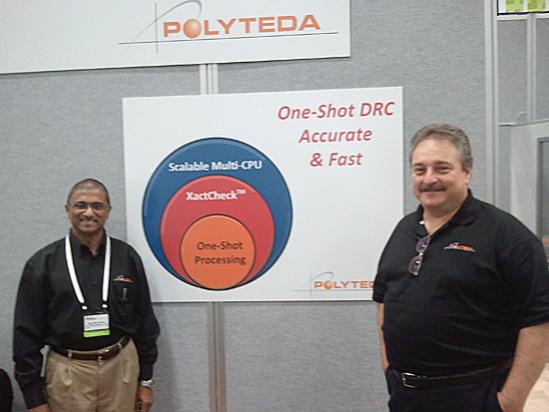Intro
Across the aisle from the Mentor booth at DAC sat a DRC tool competitor to Calibre. I received an update from Randy Smith of Polyteda on Wednesday afternoon, my last EDA vendor of the week.

Ravi Ravikumar, Randy Smith
Notes
Randy Smith – CEO (February 2011) [former founder is gone]- 1979 at HP developing internal tools
– Trilogy
– Tangent, Acquired by Cadence
– Bought 4 times
– Celestry->Cadence
– Gambit->Synopsys
– Japan consulting business
Before – big performance claims
Now – about 2 to 3X faster than Calibre while running in flat mode, PowerDRC– Look for a new hierarchical announcement by end of year, look for a new name
– Smaller memory footprint
– Easy to scale across multi-processors
– TSMC has a reference flow, while larger companies can use a new DRC tool during design process
o 3 way NDA between: Polyteda, TSMC, Client. Tune the rule deck. 40nm deck. Takes 18 months to reach sign off, stay tuned.
– OEM relationship with AWR – single CPU limitation
– IHP – customer, AMS client at 180nm (Pricing of Calibre seems too high)
– Price/Performance – produce more results with less cost than Calibre
– Learning curve: batch oriented, easy to learn, debugging is more of the issue, something similar to RVE called RDE (still internal)
– Time based licensing, tied to the number of CPUs
– Mentor has two licenses: Flat or Hierarchical
– Polyteda will have one license: Flat and Hierarchical
– Over 40 people in the company
o R&D in Moscow
o HQ in Santa Clara
Summary
Polyteda has reset expectations about their DRC tool performance and will have to battle against the entrenched Calibre in the marketplace. Competition always benefits the EDA tool users who need every advantage to get to market quickly and have first silicon success.





The Intel Common Platform Foundry Alliance